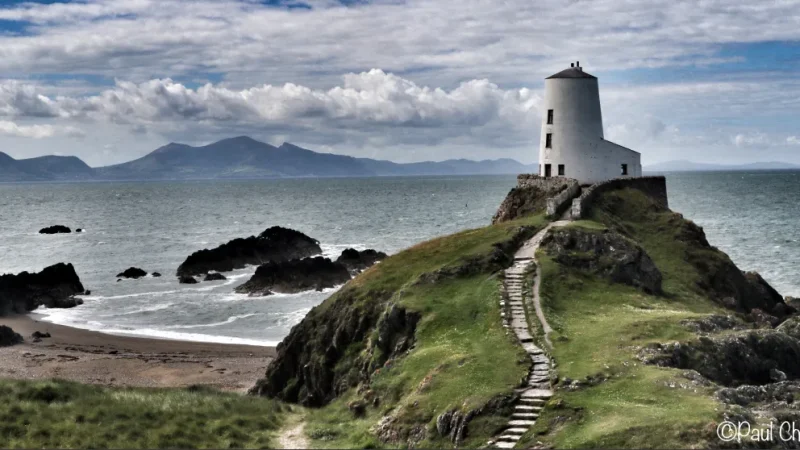Perched dramatically on the rugged coastline of Llanddwyn Island in Anglesey, Twr Mawr Lighthouse is one of the most iconic maritime structures in Wales. With its distinct whitewashed tower, panoramic sea views, and mythic Welsh heritage, Twr Mawr draws thousands of visitors each year. More than a navigational aid, this lighthouse represents a perfect confluence of natural beauty, maritime tradition, and cultural significance.
This article provides a comprehensive look at Twr Mawr Lighthouse, its history, how to visit it, what makes it unique, and why it holds a special place in Wales’ coastal narrative.
The Origin and History of Twr Mawr Lighthouse
Built in 1845, Twr Mawr (Welsh for “big tower”) was designed to guide ships through the Menai Strait — a narrow and hazardous waterway separating Anglesey from mainland Wales. It replaced a smaller, less effective beacon known as Twr Bach (“little tower”), which had been in use since the early 1800s.
Though it may resemble a windmill due to its tapered shape and lack of lantern gallery, Twr Mawr functioned efficiently as a daytime navigation point. It originally used an oil lamp and later benefited from modest technological upgrades before being decommissioned in favor of more modern lighting systems.
Today, while no longer operational as a lighthouse, Twr Mawr remains a beloved architectural relic, blending effortlessly into the windswept landscape of Llanddwyn.
Architectural Features and Design
Twr Mawr Lighthouse stands about 11 meters (36 feet) tall, constructed primarily of limestone. Its base is broad and conical, tapering gracefully toward a domed cap. The whitewashed walls, often catching the golden light of sunset, make it a photographer’s dream.
While it lacks the traditional lantern room and balcony of most lighthouses, its unique silhouette and coastal setting have made it instantly recognizable. Twr Mawr’s design also reflects local building traditions and aligns harmoniously with the surrounding ruins and chapels on the island.
Location: Llanddwyn Island, Anglesey
Twr Mawr Lighthouse is located on Llanddwyn Island, a tidal island off the southwest coast of Anglesey. The island itself is part of the Newborough Warren National Nature Reserve, offering unspoiled beaches, rolling dunes, and pine forests.
Though technically an island, Llanddwyn is accessible on foot during low tide, making it a popular walking destination. From the mainland, the lighthouse is about a 45-minute walk along the sandy shoreline or forest trails, depending on the chosen route.
Myth and Legend: Saint Dwynwen and the Island’s Spiritual Heritage
One of the reasons Twr Mawr Lighthouse feels so enchanting is its connection to Welsh mythology. The island is named after Saint Dwynwen, the patron saint of lovers in Wales. Her chapel ruins remain a significant pilgrimage site, particularly on January 25th, which is St. Dwynwen’s Day.
Many visitors come to the island not only to see the lighthouse but to soak in its deeply spiritual and romantic atmosphere. It is said that the island’s tranquility has healing powers, and many come seeking inspiration, peace, and connection.
How to Visit Twr Mawr Lighthouse
Getting There
- By Car: Drive to Newborough Forest Car Park in Anglesey. This is the nearest access point for walking to Llanddwyn Island.
- By Foot: Walk along the scenic path through Newborough Forest or along Llanddwyn Beach.
- Best Time to Visit: Visit during low tide, as the island becomes inaccessible at high tide.
Travel Tips
- Check Tides: Always verify tide times before visiting to avoid being stranded.
- Footwear: Wear sturdy walking shoes; the terrain includes sand, grass, and rocky outcrops.
- Duration: A round-trip walk and exploration typically takes 2-3 hours.
Nearby Attractions
- Twr Bach Lighthouse: The smaller predecessor to Twr Mawr, offering a fascinating comparison.
- Newborough Forest Trails: Excellent for hiking, wildlife spotting, and birdwatching.
- Ynys Llanddwyn Ruins: Explore Saint Dwynwen’s chapel, ancient crosses, and Celtic remnants.
- Anglesey Beaches: The surrounding coast is lined with pristine, often uncrowded beaches.
Photography and Nature Watching
Twr Mawr Lighthouse is a prime destination for landscape photographers. Sunrises and sunsets cast dramatic hues across the sky and sea, often framing the lighthouse in golden or pink light.
Wildlife watchers can spot red squirrels in Newborough Forest and numerous seabirds nesting in the cliffs. In spring and summer, wildflowers cover the island, adding bursts of color to the rocky landscape.
SEO Optimized Keywords and Search Intent Alignment
| Keyword | Search Intent | Content Covered |
| Twr Mawr Lighthouse | Informational, navigational | History, visiting guide, architecture |
| Llanddwyn Island | Travel planning, tourism | How to visit, things to see |
| Anglesey lighthouse walk | Activity planning | Walking route, tips, what to expect |
| Wales coastal landmarks | Tourism, cultural sites | Significance of Twr Mawr in Welsh history |
| Saint Dwynwen | Cultural/historical interest | Mythology and chapel ruins |
| Best views in Anglesey | Travel inspiration | Scenic viewpoints from and around the lighthouse |
| Tidal islands in Wales | Educational, travel | Llanddwyn Island’s status and accessibility |
Cultural and Environmental Significance
Twr Mawr Lighthouse is more than a photo stop — it’s a cultural landmark. Protected as part of Ynys Llanddwyn Heritage Site, it exemplifies Welsh heritage and maritime legacy. The site is also part of a Special Area of Conservation, ensuring it remains untouched by large-scale development.
Conservationists are actively involved in preserving the flora and fauna, while educational signs offer context about the geology and history of the area.
Why Twr Mawr Lighthouse is a Must-Visit
- Unique Structure: Unlike any other lighthouse in the UK.
- Romantic Setting: Overlooks beaches, tidal waves, and sunset skies.
- Historical Depth: Offers a deep connection to Wales’ past.
- Nature-Rich: Surrounded by dunes, pine forest, and wildlife.
- Free and Accessible: Open to all with no entry fee.
Reviews and Visitor Feedback
Travelers consistently praise Twr Mawr for its peaceful atmosphere and scenic beauty:
“One of the most breathtaking walks in Wales.”
“I felt transported to a different world — serene, sacred, and wild.”
“A hidden gem. Everyone should experience Llanddwyn at least once.”
Conclusion
Twr Mawr Lighthouse isn’t just a beacon for lost sailors — it’s a shining symbol of Welsh heritage, natural splendor, and spiritual refuge. Whether you’re a photographer, history buff, hiker, or simply someone looking for a quiet moment by the sea, this lighthouse delivers a rich, unforgettable experience.
From the romantic legends of Saint Dwynwen to the windswept vistas of the Menai Strait, every stone and wave at Twr Mawr tells a story. It’s no wonder this lighthouse continues to inspire awe — not just as a structure, but as a cultural and emotional landmark.
FAQs
1. Where is Twr Mawr Lighthouse located?
Twr Mawr Lighthouse is located on Llanddwyn Island, a tidal island off the southwest coast of Anglesey, Wales, within the Newborough National Nature Reserve.
2. Can you walk to Twr Mawr Lighthouse?
Yes, Twr Mawr Lighthouse is accessible by foot during low tide via sandy beaches or forest trails from Newborough, typically taking about 45 minutes each way.
3. Is Twr Mawr Lighthouse still operational?
No, Twr Mawr Lighthouse is no longer an active lighthouse. It was decommissioned but remains a historic monument and popular tourist destination.
4. What is the history behind Twr Mawr Lighthouse?
Built in 1845, Twr Mawr replaced the smaller Twr Bach beacon and helped guide ships through the hazardous Menai Strait until its deactivation in the 20th century.
5. What makes Llanddwyn Island special besides the lighthouse?
Llanddwyn Island is known for its stunning landscapes, Saint Dwynwen’s chapel ruins, rare wildlife, and spiritual atmosphere, making it a unique Welsh heritage site.
Also read: Anti Deodorant vs Antiperspirant: What’s the Real Difference?





